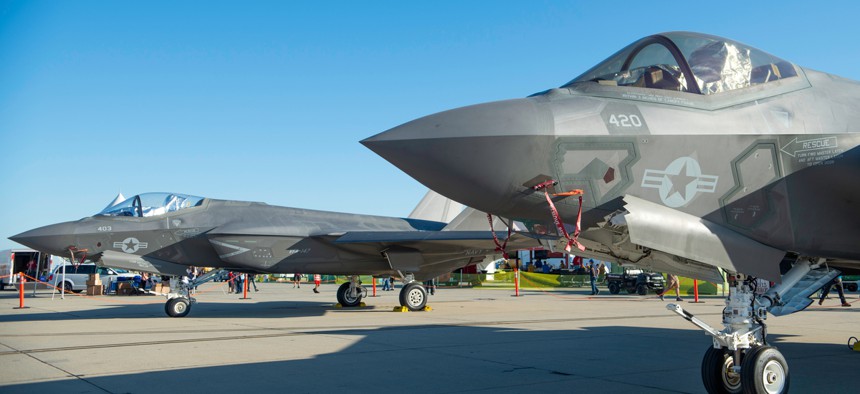Defense Officials Tout Smoother Electronic Health Records Rollout

NAS Lemoore, California, one of several sites the Defense Department's new health records platform recently debuted. Peter R Foster/Shutterstock
The second deployment of MHS Genesis went “much, much smoother” than the first, as officials take lessons from both rollouts to 25 more bases this summer.
After a rough start to the militarywide rollout of the Defense Department’s new electronic health records system, the first wave of the revitalized effort went “much, much smoother,” top officials told reporters Wednesday.
Officials hope that smoothness will lend itself to automation, as the team gears up to deploy to 25 more sites this summer.
The Defense Health Agency led deployment of the Medical Health System Genesis at four sites this fall, dubbed Wave Travis, which included Travis Air Force Base, Naval Air Station Lemoore, Presidio of Monterey in California and Mountain Home Air Force Base.
After a previous rollout at medical centers in the Pacific Northwest caused widespread frustration among hospital staff, officials vowed not to repeat the same mistakes. The Wave Travis deployment was preceded by major infrastructure improvements at all four sites and a new training regime was put in place.
“This deployment at Wave Travis was much, much smoother than we saw at IOC,” said Air Force Maj. Gen. Lee Payne, DHA’s MHS Genesis functional champion.
“We found no increase in patient safety problems and no increase in harm,” the general said.
The team has also been monitoring a system called the Global Trigger Tool, which looks at potential adverse effects on patients due to major process and technology changes.
“The good news is we’ve seen decline across the entire system, both legacy and MHS Genesis sites,” Payne said, adding there has been “no difference between our Genesis sites and our legacy systems.”
While there were still some bumps—there were issues connecting local apps to the new system and the Dentrix dental system was not configured properly at first—the team received one-third fewer trouble tickets after deployment compared with the initial rollout.
“We had a call center directly across from my office that was placed for the region—for the wave. I frequently would walk into the call center for the tickets and they would be relatively idle,” said Air Force Col. Kristen Beals, David Grant USAF Medical Center commander.
The tickets she did see during the first two weeks were mostly about adjusting user roles and access, she said.
“It was really basic, benign functionality of the system,” she said. “I was very surprised with that and very pleased that my folks were using the system in a deliberate fashion.”
“What we encountered at Wave Travis were relatively minor things,” said William Tinston, program executive officer for Defense Healthcare Management Systems. “Like the location of equipment to best support the workflows; did we have some network drops in place; did we need to continue working on training—we absolutely do. It was tremendously better than what we experienced previously but we have some work to do there.”
Tinston credited the training program for easing the transition for staff, particularly the peer-expert system that focused on training superusers in various groups—doctors, nurses, technicians—and then having those employees train others.
“It wasn’t something we were coming in from Washington and doing to them,” he said. “It was something they were doing with us.”
Tinston lauded the progress but said it now needs to scale and be automated, as the next wave will deploy at 25 sites simultaneously.
“While we made tremendous strides from our previous efforts … we need to industrialize the process, too. We need to make the deployment process such that we don’t need to swarm in with labor, people and management attention to be effective,” Tinston said. “A lot of that had to happen at Wave Travis, and we continue to strive to squeeze the labor, automate this process as much as possible, put the tools in the [Military Treatment Facility] commander’s hands so that they can be effective at managing their teams and the adoption at their facilities.”
Moving forward, the department has no hard plans for any schedule changes, meaning the next wave—Wave Nellis—including Nellis Air Force Base, Fort Irwin, Twentynine Palms, Edwards Air Force Base, Beale Air Force Base, Los Angeles Air Force Base and Vandenberg Air Force Base, is set for deployment in June 2020. On the current schedule, DHA expects to have MHS Genesis deployed at all military medical facilities by the end of 2023.
However, Tinston said that could change as the Defense Department’s system continues to integrate with the one being deployed by the Veterans Affairs Department. The VA will be rolling out the first instance of its Cerner EHR platform in March.
“As the VA begins to deploy and as the FEHRM—Federal Electronic Health Records Management—program office continues to evolve, we’ll be looking for opportunities with the VA schedule to align the VA and DOD schedules for the maximum benefit of the patient and the federal health system,” he said. “If we can bring [Major General] William Gourley [VA-DOD Outpatient Clinic] in with Monterey [Clinic] so that the folks are working on the same system—I don’t know that that’s the answer but we’ll be looking at that.”
NEXT STORY: TSA's vision for self-screening comes into focus






